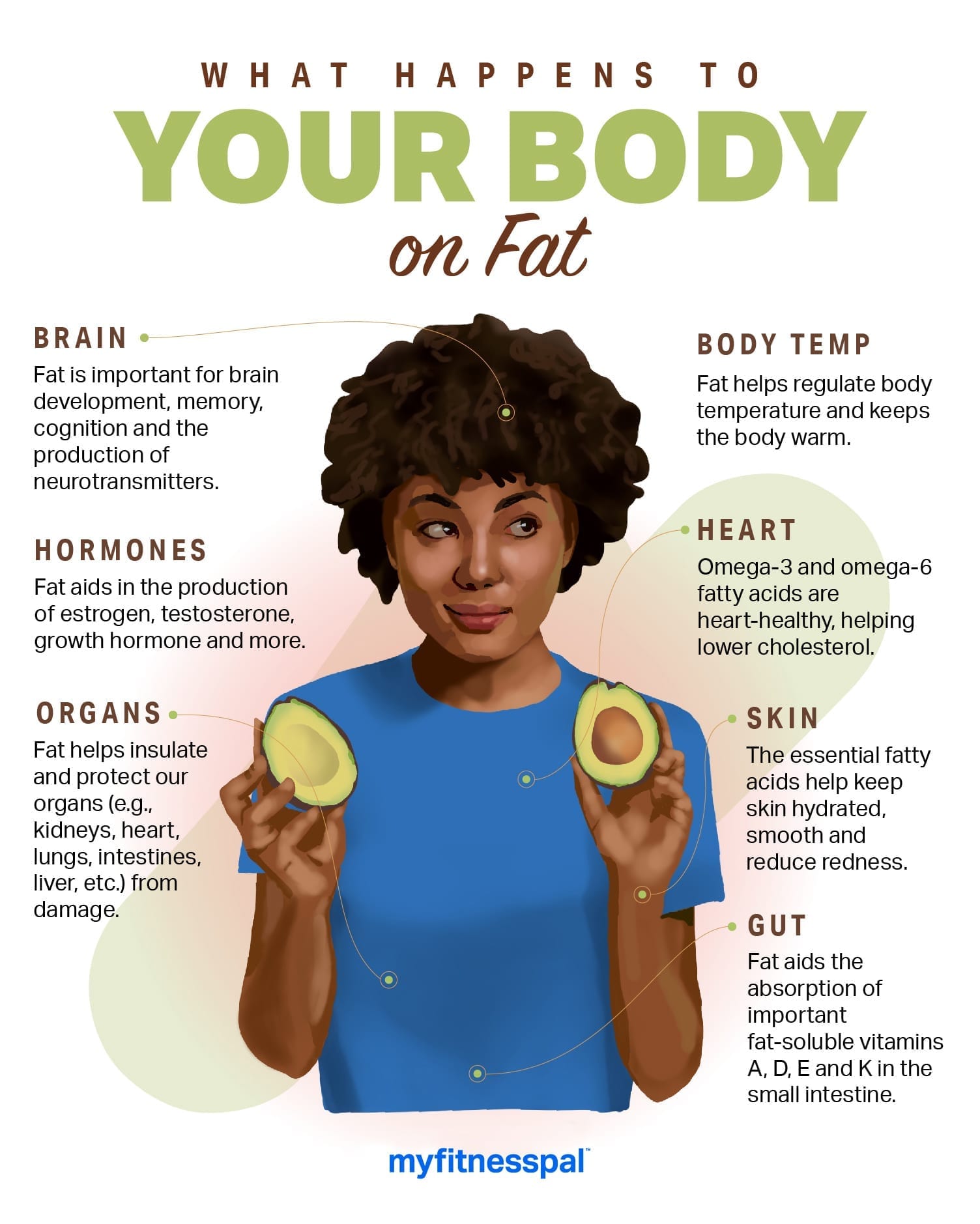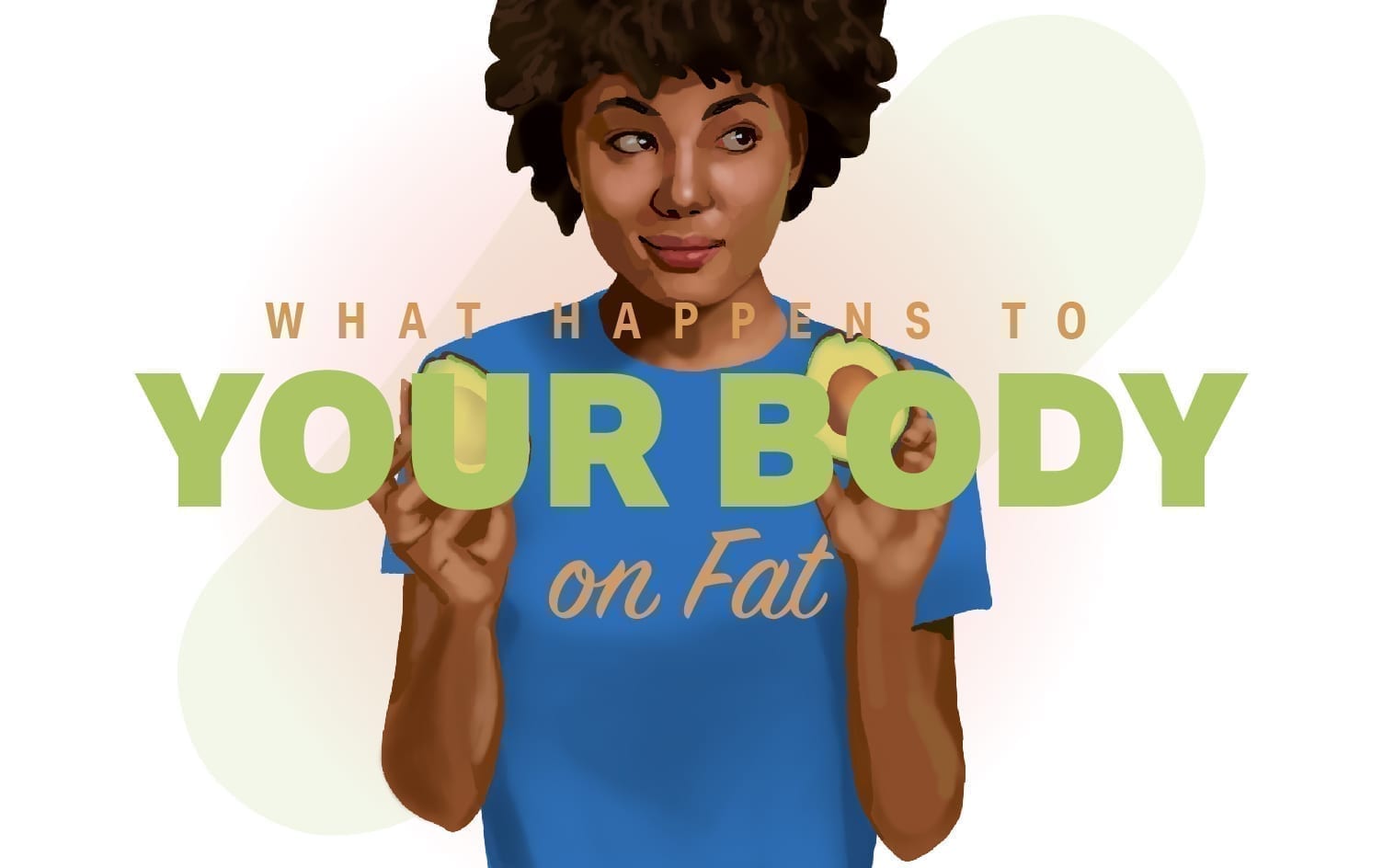Even though its reputation is much improved since the low-fat diet craze of the ‘80s and ‘90s, dietary fat still seems to be digging itself out of its reputation as being “bad.” There is still a lot of fear around fat and confusion about whether low-fat foods are best (Spoiler alert: often they are not). To understand why we need fat, it’s important to understand the role it plays in the body and the effect different types of dietary fat have on the body.

WHY WE NEED FAT
Fat serves as a backup energy source when carbohydrates aren’t readily available. It helps prevent blood sugar spikes after eating because it can slow digestion. Similar to protein, fat also promotes satiety and helps regulate appetite.
Because fat aids in producing many hormones, consuming enough dietary fat helps support the reproductive cycle and is an important factor in fertility. Fats are also essential for brain development and cognition throughout the lifecycle. Without dietary fat, the body could not absorb important vitamins A, D, E and K, which support numerous body functions like bone health, vision, immunity and reducing inflammation.
HOW WE DIGEST FAT
Fat digestion starts in the mouth when an enzyme in the saliva called lingual lipase begins to break it down. It is further digested in the stomach and enters the small intestine, where most nutrient absorption occurs. When digested fat enters the small intestine, the gallbladder releases bile (made by the liver), and the pancreas releases pancreatic lipase. Bile binds to fat molecules to emulsify them and allow lipase to break them down, passing through the small intestine and into the bloodstream. Some fats get used for energy and its various functions right away, and some get stored in fat cells.
HOW MUCH FAT DO YOU NEED?
The Institute of Medicine (IOM) recommends 20–35% of total calories from fat, but you can certainly eat more or less depending on your goals. You can track your intake with the MyFitnessPal app. It automatically allocates 30% of calories to fat, but this can be changed (along with the other macros) to suit your individual needs. For example, if you’re training for a half- or full-marathon, you might decrease your fat intake to make room for more carbohydrates, a main source of energy for endurance training.
Moreover, increasing fat intake at the expense of other macronutrients (i.e., carbs and protein) can negatively affect brain function and performance in the gym. While the keto diet (which promotes eating 90% of your calories from fat) generates a lot of buzz for weight loss, it isn’t known how the diet affects the body long-term, making experts wary. Its restrictive nature also makes it hard to sustain and could lead to nutrient deficiencies when cutting out multiple food groups.
Since fat contains 9 calories per gram, while carbs and protein each have 4 per gram, you get more than twice the calories per bite. This helps make fat so satiating, but it’s important to keep in mind a little can go a long way.
WHAT ARE THE BEST SOURCES OF HEALTHY FATS?
Monounsaturated and polyunsaturated fats are often what dietitians and health experts refer to as “healthy fats.” Omega-3 and omega-6 fatty acids (technically polyunsaturated fats) are important to mention because the body cannot produce them itself, so you have to get them from food. Both are essential in regulating the immune system, and omega-3’s support vision and the nervous system. Sources include avocado, nuts and nut butters, seeds, fatty fish like salmon and sardines (rich in omega-3’s), and oils like olive and avocado.
Saturated fats (the kind found in butter, cream, coconut and red meat) often get a bad rap since diets high in saturated fat are linked to higher cholesterol levels, increasing heart disease risk. However, many foods containing saturated fat (such as meat and dairy products) also provide other important nutrients such as protein, calcium, iron and zinc. Moreover, those who consume full-fat dairy products may be more likely to maintain a healthy weight than those who choose low-fat dairy. Thus, these foods can and should have a place in a well-balanced diet primarily focused on monounsaturated and polyunsaturated fats.
THE BOTTOM LINE
Gone are the days when choosing the low-fat versions of foods is the default healthy option. In fact, commercial low-fat foods tend to be high in sugar and other processed ingredients to make them taste good with less fat. Instead, aim to include a variety of quality, satisfying fats in your diet as a complement to complex carbs and protein that make up your meal. That may mean fatty fish with quinoa and veggies for dinner or an apple and peanut butter for a snack. Of course, there is always room for fun fats like ice cream in a varied, plant-forward diet, too.
READ MORE
> Your Body on Protein
> Your Body on Carbs
> Your Body on Sugar
Unlock an experience that’s like having a dietitian, trainer and coach — right at your fingertips. Go Premium for expert guidance and exclusive tools that will help you reach your personal health goals.




